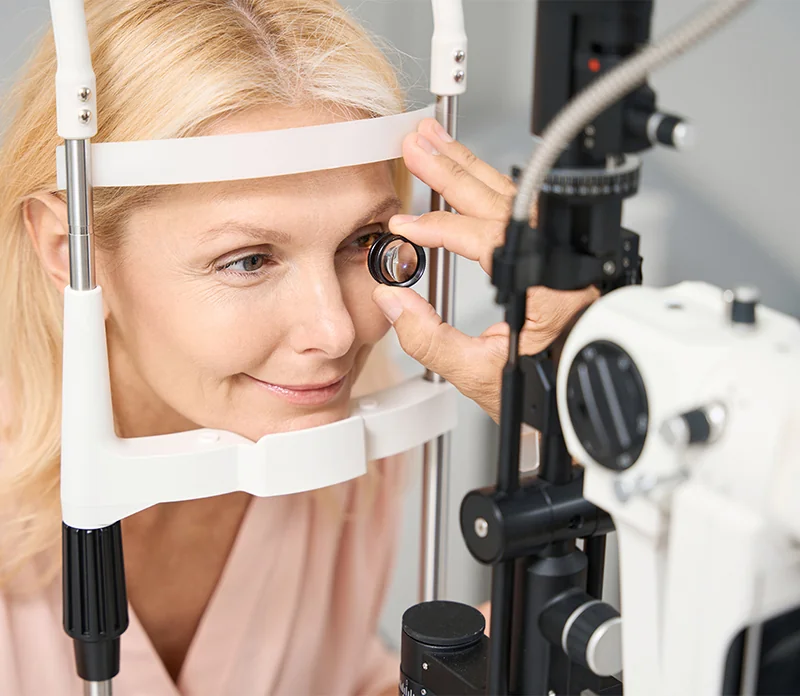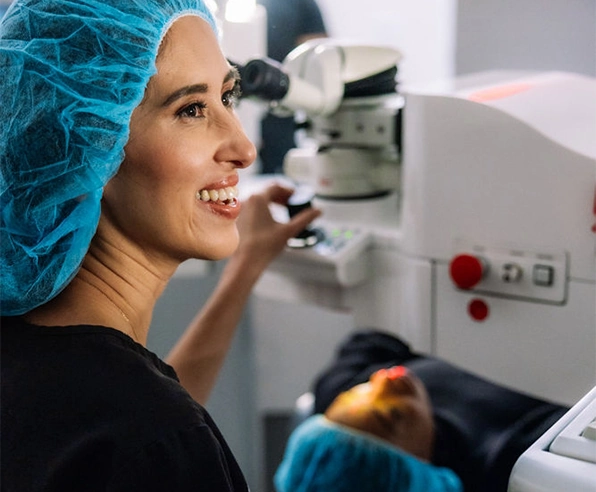
Laser Iridectomy
Laser Iridectomy

Iridectomy is a procedure in which a portion of the iris (colored part of the eye) is removed. Earlier, this procedure was done surgically, but now with the advancement in technology, it is performed with the help of lasers.
Laser iridectomy is also known as laser peripheral iridotomy (LPI). It is performed on an outpatient basis and takes about 10 minutes to complete. It is used to relieve elevated intraocular pressure (IOP) caused by impairment in the drainage of aqueous humor. IOP may also be raised due to the overproduction of aqueous humor. When IOP is raised, it can lead to a condition known as glaucoma.
What Is Glaucoma, and How Does It Damage Vision?
Glaucoma is a disease in which vision is impaired due to elevated intraocular pressure (IOP).
The eye contains a fluid known as aqueous humor, nourishing its internal structures. This fluid is produced behind the iris and then is drained out through a sieve-like structure located at the meeting point of the transparent part of the eye and the colored part of the eye.
In some eyes, abnormalities in the drainage system can impair the normal aqueous humor outflow, which can raise the intraocular pressure.
High IOP can impair proper blood supply to the optic nerves located in the back part of the eye. This impairs the communication between the eye and the part of the brain responsible for vision.

Types of Glaucoma
The angle is the space between the clear part of the eye (cornea) and the colored part of the eye (iris), close to their meeting point near the periphery of the iris. It contains trabecular meshwork, a major structure that drains fluid out of the eye. The angle can be examined by a test called gonioscopy, which is done by an eye doctor.
Glaucoma is classified broadly into open-angle glaucoma and closed angle glaucoma based on the angle.
In open-angle glaucoma, the angle is open i.e., not occluded and the problem (high eye pressure) is not related to the impairment of drainage of aqueous humor but to its overproduction.
In closed-angle glaucoma, the angle is closed in most areas, leading to drainage impairment and build-up of aqueous humor, which causes a rise in eye pressure. There is also a precursor form of the disease in which the angle is closed, but eye pressure isn’t high, and the optic nerve is not affected.
Glaucoma Treatment
Glaucoma is treated by lowering the eye’s pressure (intraocular pressure). Depending on your situation, you will be offered medical and/or surgical management to lower the intraocular pressure.
Medical treatment includes prescription eye drops and oral medications. Surgical management includes laser therapy, drainage tube insertion, and minimally invasive glaucoma surgery.
How Can Laser Iridectomy Treat Glaucoma?
Laser Iridectomy is only used to treat closed-angle glaucoma and its precursors. It is not used to treat open-angle glaucoma. For open-angle glaucoma, there are other laser procedures.
Laser iridectomy removes a portion of the iris. This provides a channel for drainage of excess aqueous humor. As excess aqueous humor is drained out, the pressure on the eye reduces. This, in turn, alleviates the symptoms of closed-angle glaucoma.

What Can You Expect During the Procedure?
Before the procedure
The procedure is done on an outpatient basis. It will be performed in a specially equipped laser room. There is no requirement for a special surgical center. Once you have settled comfortably, drops will be used to numb your eye. No injections or needles are used.
First, your ophthalmologist will apply a drop to make your pupil smaller. Constricting the pupil makes the iris stretched and thin. After this, the doctor will apply a special contact lens to your eye to focus on the iris. After this lens is applied, small eye movements are reduced. The lens keeps the eyelids separated so that you won’t blink. A gel will be placed on your eye to make sure that the contact lens does not scratch your eye. This jelly may remain on your eye for about 30 minutes, leading to blurring vision and foreign body sensation.
During the procedure
You will see a bright light like a photographer’s flash from a small distance during the procedure. As soon as the laser hits the iris tissue, you will feel a pinch-like sensation. Otherwise, the whole procedure is painless.
After the procedure
The intraocular pressure will be checked about half an hour after the laser treatment. Eye drops will be prescribed to relieve any signs of inflammation like pain and redness of the eye. Your doctor will schedule follow-ups. Follow-ups are important to monitor your eye pressure. So you should not miss any appointment with your ophthalmologist.
The doctor may ask you to continue the eye drops that make your pupil smaller for a few days. This will temporarily cause blurred vision, especially at night. Your doctor may use other drops to reduce intraocular pressure or inflammation.
You may expect to resume work immediately, but some may have problems immediately resuming work. Your eyes may remain red and sensitive to light for a few days after the procedure. You may also experience foreign body sensations in your eye for a few days.
Suitable Candidates for Laser Iridectomy
Laser iridectomy is recommended as a treatment option for eyes in which the angle is closed for at least half of the eye and has high eye pressure or glaucoma. It may be recommended as a preventive treatment in eyes that have narrow-angle but have normal eye pressure and no optic nerve damage. Studies have shown that the eyes with narrow-angle have a lower risk of developing high eye pressure if they undergo laser iridectomy.

FAQs About Laser Iridectomy
Previously, iridectomy was done surgically. There were more risks and adverse effects of surgical iridectomy. But, laser treatments are very safe when compared to surgical iridectomy.
Surgical iridectomy requires a well-equipped surgical setup and cannot be done on an outpatient basis. But laser iridectomy does not require such a surgical setup and can be done on an outpatient basis.
Also, the duration required for the laser procedure is about 10 minutes which is very less when compared to a surgical procedure.
Laser iridectomy yields promising results when coupled with medical treatment. Medical treatment alone has been found to be not as effective.
Serious side effects after laser iridectomy are rare, but like any medical procedure, it has some risks. The chance of losing vision after a laser procedure is extremely small. Few side effects have been mentioned in the previous paragraph. Other important side effects have been mentioned below:
- Headache
- Occlusion of the hole created in the iris
- Requirement of repeating the procedure if the first session fails to obtain the outcome
- A transient rise in eye pressure
- Bleeding at the laser site
- Temporary blurring of vision
The treatment immediately shows its effect, relieving symptoms of glaucoma like pain, nausea, vomiting, and halos. However, it does not bring back lost vision; it only prevents your condition from worsening.
After laser iridectomy, you should follow some precautions at home yourself. These include the following:
- Avoid looking at bright light and objects for a few days.
- Take analgesic as directed by your doctor for headaches.
- Take all the medications, including eye drops, in time as prescribed.
- Spend less time on mobile phone and laptop for a few days.
- If you feel uncomfortable even when you stick to your medications, always feel free to contact your doctor and schedule an appointment.
The procedure is contraindicated if there is an infection in the eyes. It is also not done if there is corneal edema (swelling of the clear part of the eye).
If you are experiencing severe pain in the eye, visual disturbances, redness, watering in the affected eye, headache, intermittent attacks of blurring vision, and seeing coloured halos around light, you should visit an ophthalmologist as you may need a laser iridectomy.
Laser iridectomy is used to lower rising eye pressure due to the impairment of drainage of fluid of the eye, i.e., aqueous humour. The procedure creates a hole in the peripheral region of the iris under the upper eyelid. The outflow of the fluid increases thus lowering the eye pressure.
Laser iridectomy is a simple procedure that is performed on an outpatient basis. It takes around 5-10 minutes for the procedure to complete. But, you may need to come early to prepare for the procedure, and for aftercare. Overall, you may be at the eye doctor’s office for 2 to 3 hours for your appointment.
No, the procedure will not improve your vision. The procedure does not bring back the lost vision but only prevents the vision from worsening. It is intended to prevent glaucoma from appearing or progressing.
Serious complications after a laser procedure are very rare. The chances of losing vision are extremely small. Possible complications include temporary blurring of vision, bleeding at the laser site, a temporary increase in eye pressure, and inflammation. Closure of the iridectomy may occur, requiring retreatment.
You will be provided with prescription eye drops and some oral medications to use after the treatment. It is very important that you use these drops and medications as suggested by your eye doctor. You should not miss a follow-up appointment with your doctor.
You should not drive for at least 24 hours following the treatment because your eye will be light-sensitive, and you may have some blurring of vision as well. You can have your parents, spouse, or your best friend drive you to places you must be at.
Different patients heal differently. Few patients will get alright after 1 to 2 hours following the procedure. In that case, it is possible to join work. But many patients develop light sensitivity, blurring of vision, headache, and pain in the eye temporarily. It is advisable that they join work after 24 to 48 hours in such patients.
It is advised to refrain from heavy physical activity or lifting for 3 to 4 days after the procedure. Heavy physical activity can cause an increase in the pressure of your eye, which in turn will worsen your condition.
Lens opacity or cataract may develop if the laser site is close to the pupil. This occurs due to heating and direct tissue disruption of the lens by the laser during the procedure.
The therapy exerts a lasting effect, but the age-related changes may take place near the drainage apparatus of the eye requiring other procedures and treatment. Cataract formation near the drainage apparatus can impair drainage. Such cataracts need to be extracted.
It is possible that the desired outcome is not achieved, the failure rate being about 25%. In the case of failure of the therapy, you will be required to undergo medical treatment, surgery, or other laser procedures. Your doctor will schedule close follow-ups to monitor your condition.


Are You a Candidate for
Vision Correction?
Whether you just need a general eye exam, or if you are interested in reducing or eliminating your need for glasses or contacts, our team is here to help! Contact us to book an appointment today!
The doctors at Focus Eye Care & Surgery have reviewed and approved this content.
Page Updated:


